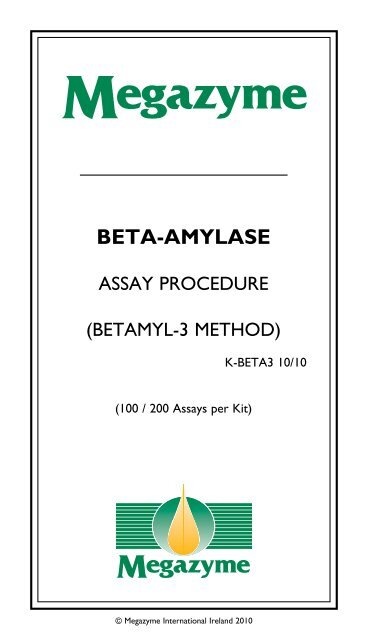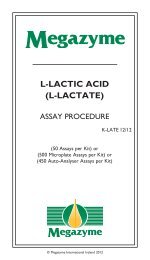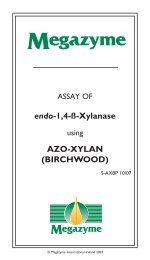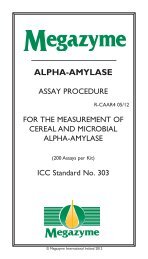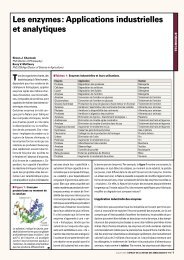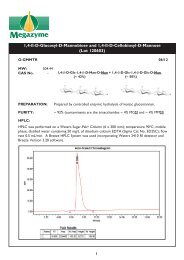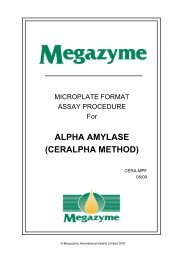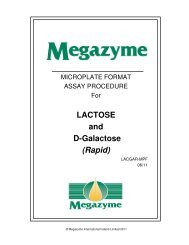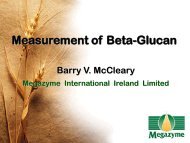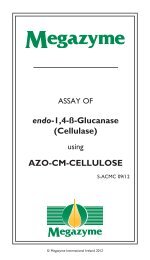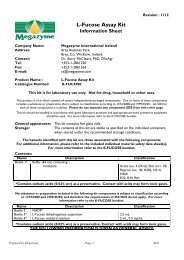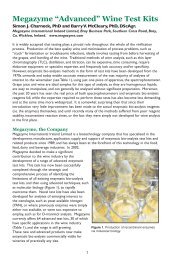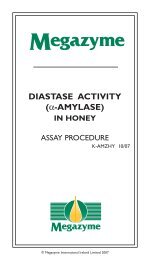BETA-AMYLASE - Megazyme
BETA-AMYLASE - Megazyme
BETA-AMYLASE - Megazyme
You also want an ePaper? Increase the reach of your titles
YUMPU automatically turns print PDFs into web optimized ePapers that Google loves.
<strong>BETA</strong>-<strong>AMYLASE</strong><br />
ASSAY PROCEDURE<br />
(<strong>BETA</strong>MYL-3 METHOD)<br />
K-<strong>BETA</strong>3 10/10<br />
(100 / 200 Assays per Kit)<br />
© <strong>Megazyme</strong> International Ireland 2010
INTRODUCTION:<br />
β-Amylase plays a central role in the complete degradation of starch to<br />
metabolisable or fermentable sugars during the germination or malting<br />
of cereal grains. It also finds considerable application, together with<br />
starch debranching enzymes, in the production of high maltose syrups.<br />
β-Amylase is usually measured using non-specific reducing sugar assays<br />
with starch as substrate. In some methods, the α-amylase is first<br />
inactivated by treatment at low pH.<br />
A major advance in the assay of β-amylase was introduced by<br />
Mathewson and Seabourn 1 who found that the Calbiochem Pantrak ®<br />
serum α-amylase reagent could be used to measure β-amylase in the<br />
presence of cereal α-amylase. The reagent (Pantrak) consists of a<br />
mixture of p-nitrophenyl-α-D-maltopentaoside (PNPG5) and<br />
p-nitrophenyl-α-D-maltohexaoside (PNPG6). These substrates are<br />
rapidly hydrolysed by β-amylase, but are only slowly cleaved by cereal<br />
α-amylase, which requires a longer stretch of α-1,4-linked D-glucosyl<br />
residues to satisfy the substrate sub-site binding requirements.<br />
Subsequently, <strong>Megazyme</strong> offered a product, Betamyl ® (β-Amylase<br />
Assay Reagent) that comprised just PNPG5 and α-glucosidase 2 ,<br />
which gave greater specificity. This reagent is now superceded by<br />
the <strong>Megazyme</strong> Betamyl-3 ® , β-Amylase assay reagent, which is more<br />
specific and considerably more stable than the Betamyl ® reagent.<br />
The <strong>Megazyme</strong> Betamyl-3 ® , β-amylase test reagent employs high<br />
purity β-glucosidase and p-nitrophenyl-β-D-maltotrioside (PNPβ-G3).<br />
The level of β-glucosidase used ensures maximum sensitivity of the<br />
assay. On hydrolysis of PNPβ-G3 to maltose and p-nitrophenyl-β-Dglucose<br />
by β-amylase, the p-nitrophenyl-β-D-glucose is immediately<br />
cleaved to D-glucose and free p-nitrophenol by the β-glucosidase<br />
present in the substrate mixture (Scheme 1). Thus, the rate of release<br />
of p-nitrophenol relates directly to the rate of release of maltose<br />
by β-amylase. The reaction is stopped, and the phenolate colour is<br />
developed, on addition of a high pH Trizma base solution.<br />
The PNPβ-G3 plus β-glucosidase mixture contains stabilisers which<br />
significantly increase its stability. The blank absorbance value of the<br />
Betamyl-3 ® substrate solution, when stored at 4 or 20°C, increases<br />
much more slowly than similar increases for Betamyl ®. reagent<br />
ACCURACY:<br />
Standard errors of less than 5% are readily achieved.<br />
SPECIFICITY:<br />
The assay is highly selective for β-amylase. The substrate is<br />
hydrolysed by α-glucosidase and amyloglucosidase.<br />
1
KITS:<br />
Kits suitable for performing 100 assays are available from <strong>Megazyme</strong>.<br />
The kits contain the full assay method plus:<br />
Bottle 1: (x2) Each vial contains p-nitrophenyl-β-D-maltotrioside<br />
(PNPβ-G3) plus β-glucosidase (50 U) and stabilisers.<br />
Stable for > 4 years at -20°C.<br />
Bottle 2: Tris/HCl buffer (25 mL, 1 M, pH 8.0) plus disodium<br />
EDTA (20 mM) and sodium azide (0.02% w/v).<br />
Stable for approx. 4 years at 4°C.<br />
Bottle 3: MES buffer (48 mL, 1 M, pH 6.2) plus disodium<br />
EDTA (20 mM), BSA 10 mg/mL and sodium azide<br />
(0.20% w/v).<br />
Stable for approx. 4 years at 4°C.<br />
Bottle 4: Cysteine hydrochloride (16 g).<br />
Stable for > 2 years at room temperature.<br />
Bottle 5: Malt flour of standardised β-amylase activity (as<br />
specified on bottle label).<br />
Stable for > 4 years at room temperature.<br />
PREPARATION OF REAGENT SOLUTIONS/SUSPENSIONS:<br />
1. Dissolve the contents of bottle 1 in 10 mL of boiled and<br />
cooled distilled water. This is Betamyl-3 ® Substrate<br />
Solution. Divide into appropriately sized aliquots and store<br />
in polypropylene tubes at -20°C between use. Store unused<br />
reagent on ice awaiting use. Do not dissolve the contents<br />
of the second bottle until required. Stable for > 2 years at<br />
-20°C.<br />
2. Dilute 2.5 mL of the contents of bottle 2 to 50 mL with<br />
distilled water. Before use, add 0.88 g of cysteine HCl<br />
(bottle 4; <strong>Megazyme</strong> cat. no. G-LCYST200) (final<br />
concentration of cysteine HCl approx. 100 mM) and adjust<br />
the pH to 8.0 with 4 M NaOH. Stable for 8 h at 4°C.<br />
3. Dilute the entire contents of bottle 3 to 500 mL with distilled<br />
water. Stable for approx. 1 year at 4°C.<br />
4. Use as supplied. Stable for > 4 years at room temperature.<br />
5. Use the contents of bottle 5 as supplied. Stable for > 4 years<br />
at room temperature.<br />
2
PREPARATION OF ADDITIONAL EXTRACTION BUFFER: 0.05 M<br />
Tris-HCl plus 1 mM EDTA<br />
Dissolve 6.06 g of trizma base (<strong>Megazyme</strong> cat. no. B-TRIS500) and 0.37<br />
g of disodium EDTA (Sigma cat. no. E4884-500G) in 700 mL of distilled<br />
water. Adjust the pH to 8.0 with 1 M HCl and the volume to one<br />
litre. Stable for approx. 3 months at 4°C.<br />
Immediately before use, add 1.75 g of cysteine HCl (<strong>Megazyme</strong> cat. no.<br />
G-LCYST200 to 100 mL of the buffer (final concentration of cysteine<br />
HCl approx. 100 mM). Adjust pH to 8.0 with 4 M NaOH.<br />
Stable for 8 h at 4°C.<br />
Cysteine is added to Buffer A (followed by pH adjustment)<br />
immediately prior to use of the buffer. Cysteine is required to<br />
extract the “insoluble” β-amylase present in ungerminated grain.<br />
This buffer has been changed from our original recommendation,<br />
based on research by Erdal (1993) and Santos and Riis (1996).<br />
Enzyme extracted without added cysteine is termed “Soluble”<br />
β-amylase; that extracted with cysteine is “Total” β-amylase.<br />
PREPARATION OF ADDITIONAL DILUTION / ASSAY BUFFER:<br />
0.1 M MES buffer plus 1 mM EDTA, 1.0 mg/mL of BSA and<br />
0.02% w/v sodium azide.<br />
Dissolve 21.3 g of MES monohydrate (<strong>Megazyme</strong> cat. no. B-MES500)<br />
and 0.37 g of disodium EDTA (Sigma cat. no. E4884-500G) in 700<br />
mL of distilled water. Adjust the pH to 6.2 with 4 M (16 g/100 mL)<br />
sodium hydroxide and the volume to 1 litre. Add 1.0 g of BSA (Sigma<br />
cat. no. A-2153) and 0.2 g of sodium azide as a preservative.<br />
Stable for > 2 years at 4°C.<br />
NOTE:<br />
1. Do not add the sodium azide to the buffer until it has been<br />
adjusted to pH 6.2. Adding sodium azide to an acidic solution<br />
results in the release of a poisonous gas.<br />
2. If buffer is prepared without adding sodium azide as a<br />
preservative, then it should be used on the day of preparation.<br />
STOPPING REAGENT:<br />
1% (w/v) Trizma base (approx. pH 8.5)<br />
Dissolve 10 g of Trizma base (<strong>Megazyme</strong> cat. no. B-TRIS500) in 900<br />
mL of distilled water. Adjust the pH to 8.5 (if necessary) and the<br />
volume to1 litre. Stable for approx. 1 year at room temperature.<br />
3
EQUIPMENT (RECOMMENDED):<br />
1. Disposable 13 mL polypropylene tubes e.g. Sarstedt cat. no.<br />
60.541.685 PP (www.sarstedt.com).<br />
2. Disposable 1.5 mL polypropylene screw cap microfuge tubes e.g.<br />
Sarstedt cat. no. 72.692 (www.sarstedt.com).<br />
3. Disposable plastic micro-cuvettes (1 cm light path, 1.5 mL) e.g.<br />
Plastibrand ® , semi-micro, PMMA; Brand cat. no. 7591 15 (www.<br />
brand.de).<br />
4. Micro-pipettors, e.g. Gilson Pipetman ® (100 μL and 200 μL).<br />
5. Positive displacement pipettor e.g. Eppendorf Multipette ®<br />
- with 5.0 mL Combitip ® (to dispense 0.2 mL aliquots of<br />
substrate solution).<br />
- with 25 mL Combitip ® (to dispense extraction buffer and<br />
3.0 mL of Stopping Reagent).<br />
6. Analytical balance.<br />
7. Spectrophotometer set at 400 nm.<br />
8. Vortex mixer (e.g. IKA ® Yellowline Test Tube Shaker TTS2).<br />
9. Stop clock.<br />
10. Bench centrifuge or Whatman GF/A glass fibre filter paper circles.<br />
11. Eppendorf centrifuge 54XX (13,000 rpm; 15,000 g).<br />
12. Laboratory mill e.g. Buhler Miag disc mill DLFU: Setting 0.2 mm<br />
(fine); Frisch Pulverisette 14 ® with 0.5 mm screen or Tecator<br />
Cyclotec ® Mill.<br />
CONTROLS AND PRECAUTIONS:<br />
1. β-Amylase is extremely unstable when highly diluted in buffers<br />
not containing other proteins. It is thus essential that additional<br />
dilution/assay buffer is prepared exactly as described, and<br />
particularly that bovine serum albumin (BSA) is included.<br />
2. For each set of assays, a reagent blank value should be<br />
determined. To obtain this value, add 3.0 mL of Stopping Reagent<br />
to 0.2 mL of pre-equilibrated Betamyl-3 ® reagent solution and<br />
then add 0.2 mL of diluted malt extract. A single reagent blank<br />
determination is sufficient for each batch of assays.<br />
3. If reagent blank absorbance value exceeds 0.3, then the<br />
Betamyl-3 ® substrate should be discarded.<br />
4. If reaction values exceed 1.8, then the enzyme extract should<br />
be diluted in Buffer B and re-assayed. Appropriate corrections to<br />
the calculations should then be made.<br />
5. PNPβ-G3 is very resistant to cleavage by cereal α-amylases, but<br />
some α-amylases, particularly those of fungal origin do cleave it.<br />
4
Thus, this assay cannot be used to specifically measure β-amylase<br />
in materials which also contain substantial levels of fungal<br />
α-amylase activity e.g. wheat flours to which fungal α-amylase has<br />
been added. The substrate is rapidly hydrolysed by α-glucosidase<br />
and amyloglucosidase.<br />
USEFUL HINTS:<br />
1. The substrate should be stored frozen between use and on ice<br />
after thawing. In the lyophilised powder form (as supplied), the<br />
substrate mixture is stable for > 4 years at -20°C.<br />
2. The number of assays which can be performed per kit can be<br />
doubled by halving the volumes of all the reagents used and by<br />
employing semi-micro spectrophotometer tubes. Do not alter<br />
the concentration of substrate in the final reaction mixture.<br />
ASSAY PROCEDURE:<br />
Enzyme Extraction:<br />
1. Mill malt or barley to pass a 0.5 mm screen with a suitable<br />
laboratory mill (e.g. Buhler Miag disc mill DLFU; Setting fine, or<br />
Frisch Pulverisette 14 ® with 0.5 mm screen).<br />
2. To exactly 0.5 g of flour in a 13 mL polypropylene tube (Sarstedt<br />
cat. no. 60.541.685 PP; www.sarstedt.com), add 5.0 mL of<br />
Extraction Buffer (Bottle 2).<br />
3. Allow the enzyme to extract over a 1 hour period at room<br />
temperature, with frequent vigorous stirring on a vortex mixer<br />
(approx. 5 times over the 1 hour period). Alternatively, place the<br />
tube into Stuart Blood Tube Rotator (http://design.hileytech.com/<br />
fisher/Stuartblood.html) which allows end-over-end mixing and<br />
run the machine for 1 hour.<br />
4. Filter an aliquot of the enzyme preparation through Whatman<br />
GF/A glass fibre filter paper, or centrifuge in a bench or microcentrifuge<br />
at a minimum of 2,000 g for 10 min.<br />
5. Add 0.2 mL of filtrate to 4.0 mL of Dilution/Assay Buffer B (bottle<br />
3), mix, and use this for the assay of β-amylase activity.<br />
NOTE:<br />
If the level of α-amylase is to be assayed in the same extract using<br />
the Ceralpha method, proceed as follows:<br />
1. Add 0.2 mL of the diluted malt or barley extract (as used in<br />
the Betamyl-3 ® assay above ) to 3 mL of Ceralpha Buffer A<br />
(prepared as shown on page 3 of the Ceralpha Booklet -<br />
K-CERA).<br />
2. Proceed with assay of α-amylase (page 7 of this booklet).<br />
5
Assay of β-Amylase:<br />
1. Dispense 0.2 mL aliquots of the diluted malt extract directly to<br />
the bottom of 13 mL polypropylene tubes and pre-incubate the<br />
tubes at 40°C for approx. 5 min.<br />
2. Pre-incubate Betamyl-3 ® Substrate Solution at 40°C for approx.<br />
5 min.<br />
3. To each tube containing diluted malt extract add 0.2 mL of<br />
Betamyl-3 ® Substrate Solution, stir on a vortex mixer and<br />
incubate tubes at 40°C for exactly 10 min (from time of addition).<br />
4. At the end of the 10 min incubation period, add 3.0 mL of<br />
Stopping Reagent and stir the tube contents.<br />
5. Read the absorbance of the reaction solutions and the<br />
reagent blank at 400 nm against distilled water.<br />
CALCULATION OF ACTIVITY:<br />
Units of β-Amylase / g of flour:<br />
One Unit of activity is defined as the amount of enzyme, in the<br />
presence of excess thermostable β-glucosidase, required to release<br />
one micromole of p-nitrophenol from PNPβ-G3 in one minute under<br />
the defined assay conditions, and is termed a Betamyl-3 ® Unit.<br />
Units/g Flour:<br />
= ∆A 400 x Total Volume in Cell x 1 x Extraction Volume x Dilution<br />
Incubation Aliquot Assayed ε mM Sample Weight<br />
Time<br />
∆A 400 x 3.4 x 1 x 5 x 21<br />
= 10 0.2 18.1 0.5<br />
= A 400 x 19.72<br />
where:<br />
ΔA 400 = Absorbance (sample) - Absorbance (blank)<br />
Incubation time = 10 min<br />
Total volume in cell = 3.4 mL (or 1.7 mL)<br />
Incubation time = 10 min<br />
Aliquot assayed = 0.2 mL (or 0.1 mL)<br />
ε mM p-nitrophenol =<br />
18.1 (at 400 nm)<br />
in 1% Trizma base<br />
Extraction volume = 5 mL per 0.5 g of malt<br />
Dilution = 0.2 to final volume of 4.2 mL (i.e. 21 fold).<br />
6
Assay of α-Amylase in malt extracts:<br />
(Note: for complete details of Ceralpha method and required reagents,<br />
refer to the K-CERA booklet).<br />
1. Dispense 0.2 mL aliquots of suitably diluted malt extract (see<br />
Note on page 5) directly to the bottom of 13 mL polypropylene<br />
tubes and pre-incubate the contents at 40°C for approx. 5 min.<br />
2. Pre-incubate Amylase HR Reagent ® at 40°C for approx.<br />
5 min.<br />
3. To each tube containing diluted malt extract add 0.2 mL of<br />
Amylase HR Reagent ® , stir on a vortex mixer and incubate<br />
tubes at 40°C for exactly 10 min (from time of addition).<br />
4. At the end of the 10 min incubation period, add 3.0 mL of<br />
Stopping Reagent and stir the tube contents.<br />
5. Read the absorbance of the reaction solutions and the<br />
reagent blank at 400 nm against distilled water.<br />
CALCULATION OF ACTIVITY:<br />
One Unit of activity is defined as the amount of enzyme, in the<br />
presence of excess thermostable α-glucosidase, required to release<br />
one micromole of p-nitrophenol from BPNPG7 in one minute under<br />
the defined assay conditions, and is termed a Ceralpha ® Unit.<br />
Units/g Flour:<br />
= ΔE 400 x Total Volume in Cell x 1 Extraction Vol. x Dilution<br />
Incubation Aliquot Assayed E mM Sample Weight<br />
Time<br />
= ΔE 400 x 3.4 x 1 x 5 x 336<br />
10 0.2 18.1 0.5<br />
= ΔE 400 x 315.6<br />
where:<br />
ΔA 400 = Absorbance (sample) - Absorbance (blank)<br />
Incubation time = 10 min<br />
Total volume in cell = 3.4 mL (or 1.7 mL)<br />
Aliquot assayed = 0.2 mL (or 0.1 mL)<br />
ε mM p-nitrophenol = 18.1 (at 400 nm)<br />
in 1% Trizma base<br />
Extraction volume = 5 mL per 0.5 g of malt<br />
7
Dilution = 0.2 to volume of 4.2 mL (i.e. 21 fold)<br />
then 0.2 mL to 3.2 mL (a further 16-fold)<br />
= 21 x 16 = 336-fold.<br />
DETERMINATION OF, AND ALLOWANCE FOR, THE DEGREE<br />
OF α-<strong>AMYLASE</strong> INTERFERENCE IN THE ASSAY:<br />
Cereal α-amylase hydrolyses Betamyl-3 ® substrate at less than 1%<br />
the rate of β-amylase.<br />
RELATIONSHIP BETWEEN UNITS OF ACTIVITY ON Betamyl<br />
(based on PNPG5) and Betamyl-3 ® (PNPβ-G3) SUBSTRATES for<br />
Barley Malt β-Amylase:<br />
Units on Betamyl ® substrate / Betamyl-3 ® substrate = 58.6<br />
CONVERSION OF ACTIVITY on PNPβ-G3 TO<br />
INTERNATIONAL UNITS ON STARCH SUBSTRATE:<br />
The activity of purified β-amylases (devoid of α-amylase,<br />
α-glucosidase and glucoamylase) on Betamyl-3 ® substrate and on<br />
soluble starch (assayed using the Nelson/Somogyi reducing sugar<br />
procedure) have been compared and conversion factors obtained.<br />
The ratios of activities on starch compared to Betamyl-3 ® for<br />
β-amylases from barley malt, wheat, soybean, sweet potato and<br />
Bacillus cereus are given below:<br />
Source of β-Amylase<br />
Ratio of Activity: Starch/Betamyl-3<br />
Malted barley 39.7<br />
Barley 40.1<br />
Wheat 20.3<br />
Soybean 21.2<br />
Sweet potato 193.9<br />
Bacillus cereus 352.2<br />
Table 1. The ratio of activity of β-Amylase enzymes from different sources<br />
on starch compared to Betamyl-3 reagent.<br />
REFERENCES:<br />
1. Mathewson, P. R. and Seabourn, B. W. (1983). Journal of Agriculture and Food<br />
Chemistry, 31, 1322-1326.<br />
2. McCleary, B. V. and Codd, R. (1989). Journal of Cereal Science, 9, 17-33.<br />
3. Erdal, K., Jensen, M. O., Kristensen, M., Krogh, J. J., Riis, P. and Vaag, P., E. B. C.<br />
Proceedings of the 24th European Brewery Convention Congress, Oslo, 1993, 147.<br />
4. Santos, M. M. and Riis, P. (1996). Journal of the Institute of Brewing, 102, 271-<br />
275.<br />
8
Figure 1. Effect of the substrate concentration (in the presence of excess<br />
β-glucosidase) on rate of hydrolysis of PNPβ-G3 by pure barley β-amylase.<br />
The arrow shows the final concentration in the Betamyl-3 ® reagent mixture.<br />
Figure 2. Time course of hydrolysis of PNPβ-G3 (in Betamyl-3 ® reagent) by<br />
pure barley β-amylase, as shown by the increase in absorbance at 400 nm.<br />
9
Figure 3. Comparison of activity of β-amylase in ten malt samples on<br />
Betamyl ® substrate (PNPG5 plus α-glucosidase) and Betamyl-3 ® substrate<br />
(containing PNPβ-G3 plus β-glucosidase).<br />
Units on Betamyl ® Reagent = 58.6 x Units on Betamyl-3 ® Reagent.<br />
Sample Ceralpha Betamyl-3 Diastatic Power DP ( o IoB)<br />
(U/g) (U/g) (EBC)WK (Units/100 g)<br />
(Units/100 g)<br />
A1 157.8 13.1 243 67.3<br />
A2 153.7 13.8 239 66.2<br />
A3 218.1 14.8 242 67.0<br />
A4 258.8 16.4 212 59.2<br />
A5 294.8 15.0 218 60.8<br />
A6 324.1 16.2 251 69.4<br />
A7 334.5 17.4 242 67.0<br />
A8 268.6 10.5 226 62.9<br />
A9 241.1 15.7 253 69.9<br />
A10 187.8 15.1 229 63.6<br />
B1 172.0 13.9 220 61.3<br />
B2 186.8 17.7 228 63.4<br />
B3 183.0 17.9 220 61.3<br />
B4 174.2 17.4 233 64.7<br />
B5 202.9 12.8 229 63.6<br />
B6 192.5 16.8 253 69.9<br />
B7 353.5 9.6 217 60.5<br />
B8 167.3 14.4 230 63.9<br />
B9 263.5 11.8 207 57.9<br />
B10 278.7 13.1 233 64.7<br />
Table 1. Comparison of values obtained for α-amylase (Ceralpha), β-amylase<br />
(Betamyl-3 ® ) and Diastatic Power for a number of malt samples. Diastatic<br />
Power was determined using Analytica-EBC Method 4.12 (Diastatic Power of<br />
Malt), and DP ( o IoB) calculated as DP ( o IoB) = [DP (WK) + 16] / 3.85. As<br />
can be seen from the data, there is no correlation between DP and either<br />
β-amylase or α-amylase activity.<br />
10
Scheme 1. Theoretical basis of the Betamyl-3 ® β-amylase assay procedure.<br />
When PNPβ-G3 is cleaved to maltose and PNPβ-G, the latter is rapidly<br />
cleaved to p-nitrophenol and glucose by the excess quantities of β-glucosidase<br />
which is an integral part of the reagent mixture.<br />
<strong>Megazyme</strong> International Ireland,<br />
Bray Business Park, Bray,<br />
Co. Wicklow,<br />
IRELAND.<br />
Telephone: (353.1) 286 1220<br />
Facsimile: (353.1) 286 1264<br />
Internet: www.megazyme.com<br />
E-Mail: info@megazyme.com<br />
WITHOUT GUARANTEE<br />
The information contained in this booklet is, to the best of our knowledge, true and accurate, but<br />
since the conditions of use are beyond our control, no warranty is given or is implied in respect of<br />
any recommendation or suggestions which may be made or that any use will not infringe any patents.<br />
11


